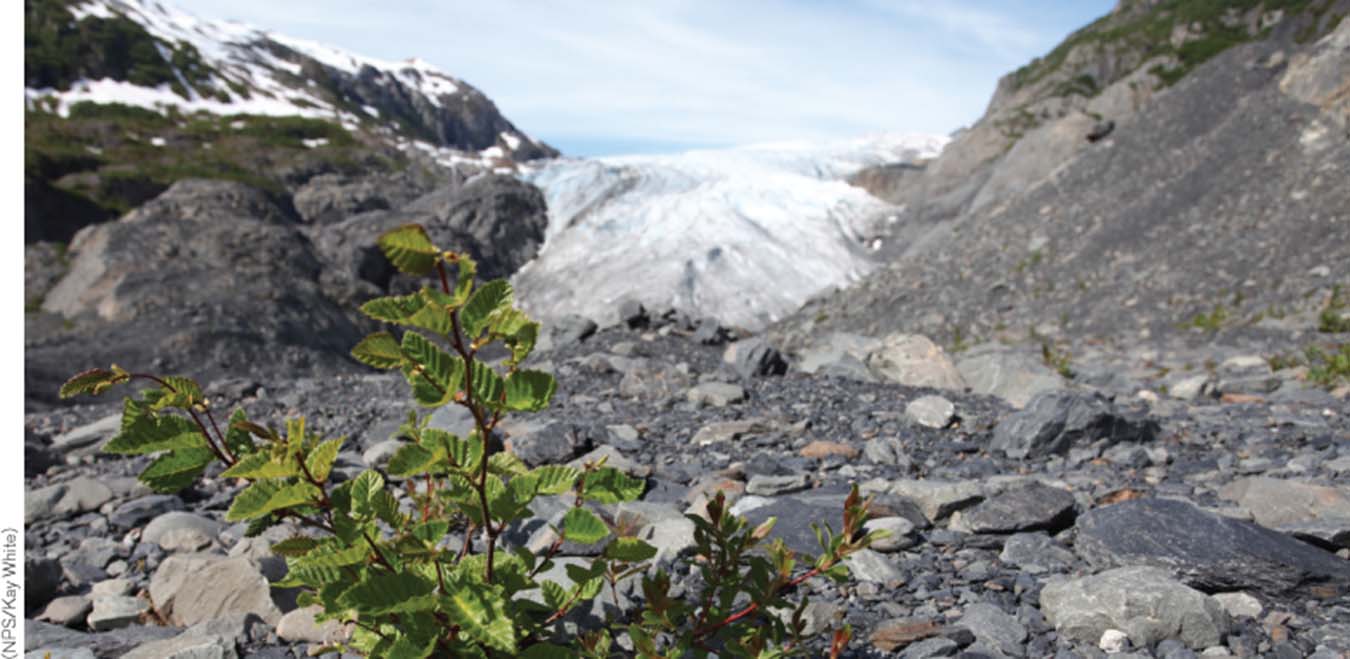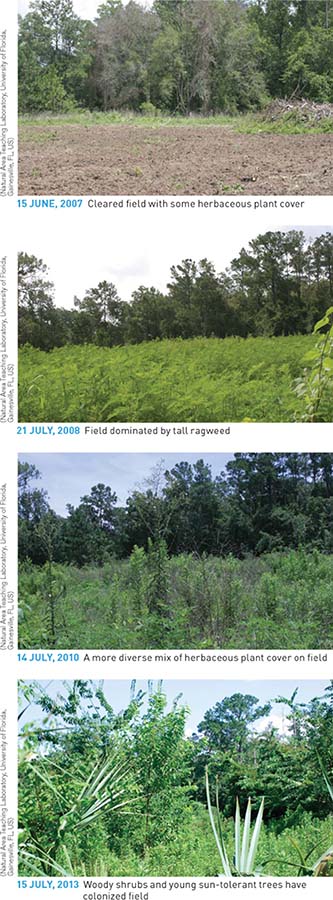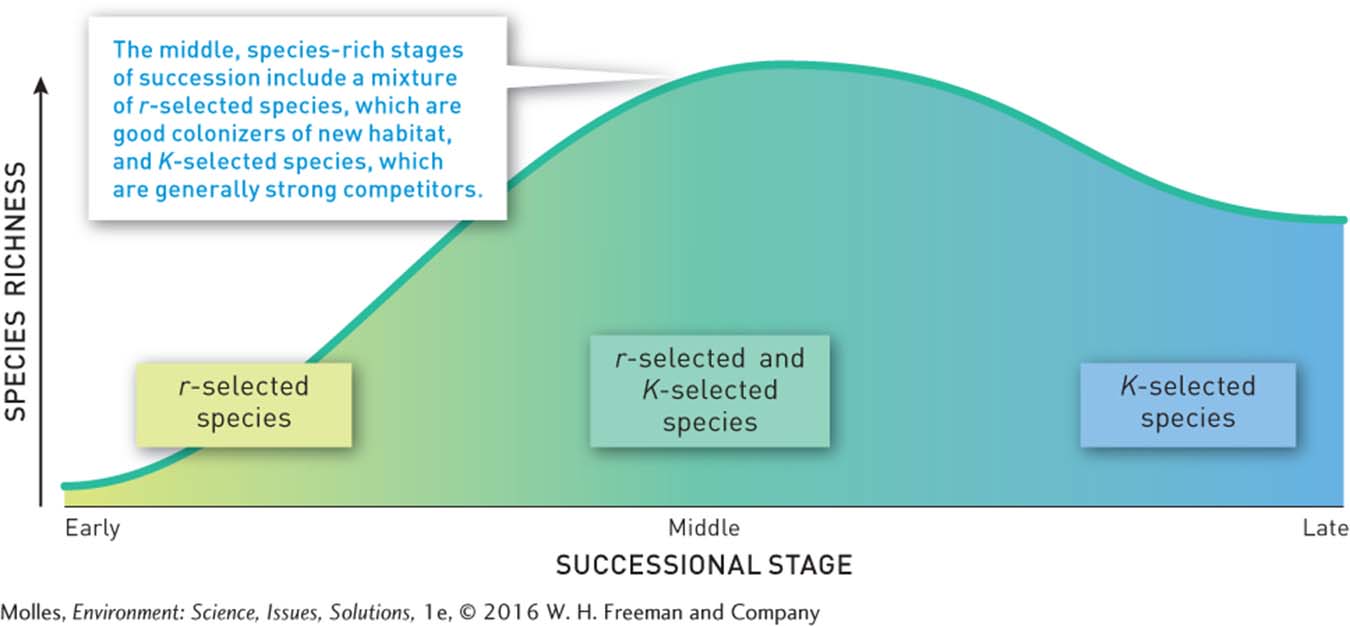4.4 Ecological succession affects community composition and diversity
succession The gradual change in a community over time following a disturbance.
After a disturbance, such as an intense forest fire, disrupts an established biological community, or when a new substrate, such as ash from a volcano, is laid down, microorganisms, plants, and animals begin to colonize the affected area. As these organisms establish themselves, they modify the environment, starting a process of ecological change called succession, which is the gradual change in a community over time following a disturbance.
primary succession Succession on a bare geologic surface, such as a recent lava flow.
Succession on a bare geologic surface, such as a recent lava flow, is called primary succession. It is generally a slow process, requiring hundreds or thousands of years, because it begins in the absence of well-developed soil. One example of this is the succession that takes place on the stones and gravel exposed by a retreating glacier (Figure 4.14). The earliest colonizers must be tolerant of low nutrient conditions. Many of these “pioneer” species, including plants and lichens (an association between a fungus and cyanobacteria), do not depend entirely on soil nutrients because they are capable of getting nitrogen from the air (for more on the nitrogen cycle, see Chapter 7, page 192).
PRIMARY SUCCESSION FOLLOWS GLACIER RETREAT

FIGURE 4.14 As glaciers retreat, they expose mineral substrates, including stones, gravel, and sand. Over time, this surface is gradually colonized, initiating a successional process that may take many centuries.
(NPS/Kay White)
pioneer community The earliest community to develop during succession.
The earliest community to develop during succession, called a pioneer community, is made up mainly of species that are tolerant of exposure to full sun, capable of living under conditions that are stressful to many other species. These pioneer species also generally have high reproductive rates and good dispersal abilities. Gradually, as these early organisms grow and shed detritus, which is consumed by fungi, worms, and other detritivores, nutrient-rich soil forms. As soil builds, conditions become suitable for the establishment of grasses and herbs, then shrubs and trees. In time, a forest could develop on the site.

Should the goal of conservation be to eliminate all forms of disturbance? Explain.
secondary succession Succession following disturbance of an established community that doesn’t destroy all living creatures or the soil.
climax community The community at the end of a successional sequence that persists until a disturbance disrupts it sufficiently to restart succession.
Succession following a disturbance of an established community that doesn’t destroy all living creatures or the soil is called secondary succession, because the process occurs on a landscape already much modified by organisms. For example, after an agricultural field is abandoned, it may gradually become forested again. Early in succession, annual plants—those that germinate from seeds, then grow, set seeds, and die within one year—with high reproductive rates and rapid dispersal ability will dominate the plant community. Later, perennial herbs, grasses, and shrubs, with more restricted environmental requirements, will establish themselves, displacing many of the earliest, pioneer plant species. Next, we might see fast-growing pine trees. Eventually, the pines will be overgrown and replaced by slower-growing deciduous trees, such as oak and hickory. These will become the foundation species of the climax community, which will remain stable until the next disturbance (Figure 4.15). The species making up the climax community will, of course, depend on the biome in which succession occurs.
Page 107
EXAMPLE OF SECONDARY SUCCESSION: OLD-FIELD SUCCESSION

FIGURE 4.15 During old-field succession in eastern North America, the succession of communities will generally pass through several predictable stages. The initial stage consists of bare soil immediately following abandonment of the field. Second, an early successional community consists mainly of annual plants capable of colonizing bare soil. Third, a later stage of mixed perennial and annual herbaceous develops. Fourth, an early forest stage consists mainly of young, fast-growing, sun-tolerant trees and shrubs. Finally (not shown here), there is an ultimate successional stage of trees that can germinate and grow in the shade of mature, sun-tolerant trees.
(Natural Area Teaching Laboratory, University of Florida, Gainesville, FL, US) (Natural Area Teaching Laboratory, University of Florida, Gainesville, FL, US) (Natural Area Teaching Laboratory, University of Florida, Gainesville, FL, US) (Natural Area Teaching Laboratory, University of Florida, Gainesville, FL, US)
As succession unfolds, the sequence of species that arrive have different life histories (see Chapter 3, page 71). The communities during the early stages of succession are dominated by the r-selected species (many offspring, wide dispersal) characteristic of disturbed environments, while the later stages of succession favor K-selected species (few offspring, slow growth). Between these two endpoints, mid-successional communities are formed from a mixture of r- and K-selected species. As a result, the middle stages of succession are generally richer in species than either early or late successional stages (Figure 4.16).
SPECIES RICHNESS AND COMPOSITION CHANGES DURING SUCCESSION

FIGURE 4.16 The number of species in a community increases rapidly during the early stages of succession and generally reaches a peak during the middle stages, declining during the later stages. The middle, species-rich stages of succession include a mixture of r-selected species, which are good colonizers of new habitat, and K-selected species, which are generally strong competitors. (After Guo, 2003)
Think About It
Considering that disturbance is a natural part of the environment, why might human-caused disturbance often have a more negative impact on biodiversity?
What would the life histories of species be like in a world with frequent and intense disturbances everywhere?
If pioneer species are so good at colonizing and dominating space during the early stages of succession, why does their dominance not extend through the later stages of succession?



